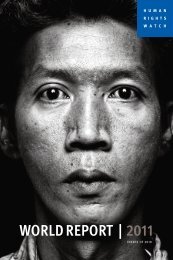SUPREME COURT OF CANADA CITATION: Alberta v. Hutterian ...
SUPREME COURT OF CANADA CITATION: Alberta v. Hutterian ...
SUPREME COURT OF CANADA CITATION: Alberta v. Hutterian ...
Create successful ePaper yourself
Turn your PDF publications into a flip-book with our unique Google optimized e-Paper software.
[16] The chambers judge found that “the implementation of mandatory photographiclicences, together with facial recognition software, is rationally connected to the objective ofsafeguarding the system of issuing operator’s licences from fraud and for that mat[t]er the largerobjective of limiting identity theft” (para. 16). He went on to find, however, that the requirementof minimal impairment was not met, in that the government had not accommodated the “distinctivecharacter of the burdened group ... to the point of undue hardship” (para. 18), citing Multani v.Commission scolaire Marguerite-Bourgeoys, 2006 SCC 6, [2006] 1 S.C.R. 256. Theaccommodations offered by the Province would still require members to have their photos taken andoffend the right. On the other hand, the Colony claimants’ proposal that the driver’s licence bemarked “not to be used for identification purposes” would satisfy the Colony members’ concernsand also meet the government’s objectives, since an individual seeking to impersonate the holderwould be “significantly limited in the extent to which he or she could use the licence” (para. 28).[17] Although it was unnecessary, in view of his finding on minimal impairment, thechambers judge went on to consider proportionality of effects. He observed that while therequirement of photos combined with facial recognition software “may safeguard the system ofissuing licences against fraud, and thereby constitute a useful tool against identity theft in general”,this did not “safeguard the identity of thousands of other individuals to whom operators’ licencesare never issued because they do not qualify to drive” (para. 31). He concluded: “In this regard, theeffects of the measure appear somewhat limited when weighed against the acknowledged incursionupon the religious beliefs of the members of the applicant Colony” (para. 32).[18] The chambers judge concluded that the regulation is inconsistent with the Charter “to
















